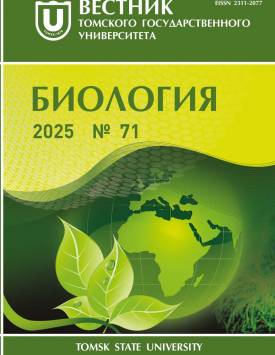Local diversity of untilled chernozem soils in the forest-steppe of the Central Russian Upland (European Russia)
Native, never-plowed Chernozem areas are practically non-existent in the forest-steppe zone of the Eastern European Plain. Therefore, the study, inventory, mapping, and assessment of soil diversity in these areas are essential for addressing geographic, genetic, and practical issues. This paper presents the results of a comprehensive soil survey carried out at the "Korovino" site, which has been under a mowing/grazing regime for at least 240 years (See Fig. 1). A topographic survey was also conducted, and soil drilling to a depth of two meters was performed at 36 locations along a regular grid (See Fig. 2). Six profiles were established for detailed soil analysis for identified areas of Haplic and Luvic Chernozem. The vegetation cover of the area is shown (See Fig. 3). The assessment of taxonomic distances, as a measure of contrast between soils, is based on a matrix of soil properties (See Table 1), where the rows correspond to classification-relevant characteristics and the columns represent the soils studied. Each cell indicates the presence (ranging from 0.1 to 1) or absence (0) of a property within the soil, with the weight of each property assigned according to a hierarchical classification system. The taxonomic distance is defined as the Euclidean distance between the column vectors of the matrix. We produce four soil maps, each using different classification units - types, subtypes, species and phases - as mapping units. For each of the maps, we calculate the number of ranges and the indices of richness, Shannon, Simpson, and Rao. Statistical calculations have been performed to evaluate the variability of the chernic horizon, humus profile (chernic + mollic horizons), and effervescence line in the soils of the study area. The soils in this area are mainly represented by Haplic and Luvic Chernozems (See Fig. 4), with well-developed granular and cloddy-granular structures in the AU horizon, and also root beads, coprolites, and various forms of carbonate neoformations. Iron-manganese neoformations have been identified in the BCAq/Cca,q and Cca,q horizons of eight soil samples with texture heterogeneity. A significant feature of these soils is the high degree of material disturbance, manifested in the presence of coprolites and krotovinas up to 20 cm in size, both direct and reverse. The coefficients of intra-profile variation, variation within areas, and variation across the entire site for the thickness of the chernic horizon, humus profile (chernic + mollic horizons), and effervescence line are closely aligned, not exceeding 20% (See Table 2). However, the difference between the extremes within the site can reach up to 30 cm for the chernic horizon, 60 cm for chernic + mollic horizons, and 70 cm for effervescence line. The investigated soils show a left-sided asymmetry in the distribution of the thickness of the chernic+ mollic horizon and a left-sided asymmetry in the distribution of BCA horizon thickness (horizon with secondary carbonates; See Fig. 5), indicating a prevailing trend of decreasing thickness in the humified part of soil profiles and BCA horizons in the investigated soils. With regard to the effervescence line, a right-sided asymmetry in this characteristic was observed, indicating a trend towards carbonate leaching. The main part of the site has a humus profile with a thickness of 100-110 cm and an effervescence line at a depth of 80-90 cm (see Fig. 6). The dominant soil types in the study area (See Fig. 7) are Haplic Chernozem (Siltic, Hyperhymic, Pachic) with 80-120 cm thick chernic + mollic horizons and an effervescence line deeper than 50 cm at approximately half of the site area. At approximately one-quarter of the site area, there are also areas of Luvic Chernozem (Siltic, Hyperhymic, Pachic, Bathygleyic), Luvic Chernozem (Siltic, Hyperhymic, Pachic, Bathygleyic) with chernic + mollic horizon thickness of 80-120 cm and effervescence line deeper than 80 cm, Haplic Chernozem (Siltic, Hyperhymic, Pachic) with chernic + mollic horizon thickness of more than 120 cm and effervescence line deeper than 50 cm, and Haplic Chernozem (Siltic, Hyperhymic, Pachic, Bathygleyic) with chernic + mollic horizon thickness of 80-120 cm and effervescence line deeper than 50 cm (See Figs. 6, 7). The soil cover in the area has a low contrast, as shown by the calculations of taxonomic distances. The average value is 0.7 out of the possible 2.98. In general, soils of low contrast are found next to each other within the site, while soils of high contrast are found at opposite ends of the site. The Shannon and Simpson diversity indices and the number of polygons on the map double when the classification level of the mapped units decreases from types to subtypes and then to species (See Table 3). The values of Rao's quadratic entropy index, which takes into account not only the number of areas and their proportion of the total area (as Shannon and Simpson indices) but also the contrast between soils, increase as the level of classification of mapped units decreases. A sharp twofold increase is observed when transitioning from the subtype level to the species level, suggesting that the species level may be the most suitable for evaluating quantitative diversity in native soils in the forest-steppe region. The article contains 7 Figures, 3 Tables, 30 References. The Authors declare no conflict of interest.
Keywords
pedodiversity, soil cover pattern, soil mapping, soil security, Belgorod oblastAuthors
| Name | Organization | |
| Smirnova Maria A. | M.V. Lomonosov Moscow State University | summerija@yandex.ru |
| Chendev Yuri G. | Belgorod State National Research University | sciences@mail.ru |
| Narozhnaya Anastasia G. | Belgorod State National Research University | narozhnyaya_A@bsu.edu.ru |
References

Local diversity of untilled chernozem soils in the forest-steppe of the Central Russian Upland (European Russia) | Vestnik Tomskogo gosudarstvennogo universiteta. Biologiya - Tomsk State University Journal of Biology. 2025. № 71. DOI: 10.17223/19988591/71/2
